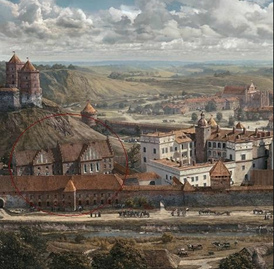Radziwiłł palace on Radvilų str.
The territory, which encompasses the current Radvilų, Žygimantų, T. Vrublevskio, and Tilto streets, from the end of 15th century, belonged to the Radziwiłł family. In the middle of the 16th century, Grand Hetman of Lithuania Jerzy Radziwiłł (d. 1541) built his palace in this place.
At the beginning of the 17th century, this palace had its golden age. Krzysztof Radziwiłł (1585-1640) reconstructed this palace in an intricate style of Italian mannerism. In 1655-1661, when Vilnius was occupied by the Muscovite army, the building had been heavily devastated. After the war with Russia, the palace was abandoned and slowly turned into decay, when in 1705, the remains of the old Radziwiłł palace were destroyed by a huge fire.
At the beginning of the 17th century, this palace had its golden age. Krzysztof Radziwiłł (1585-1640) reconstructed this palace in an intricate style of Italian mannerism. In 1655-1661, when Vilnius was occupied by the Muscovite army, the building had been heavily devastated. After the war with Russia, the palace was abandoned and slowly turned into decay, when in 1705, the remains of the old Radziwiłł palace were destroyed by a huge fire.
It seems unbelievable, even sensational, as some researchers maintain, that one of the brightest celebrities of seventeenth-century Europe, a physician, mathematician, writer, Talmudist, astronomer, music theorist, and philosopher Joseph Solomon Rofe (1591–1655), widely known as Delmedigo, not only visited but also worked in Vilnius and lived in these Duke Krzysztof II Radziwiłł’s palace.
Learn more about the famous Krzysztof Radziwiłł’s physician by clicking this link.
Address: Radvilų str.



